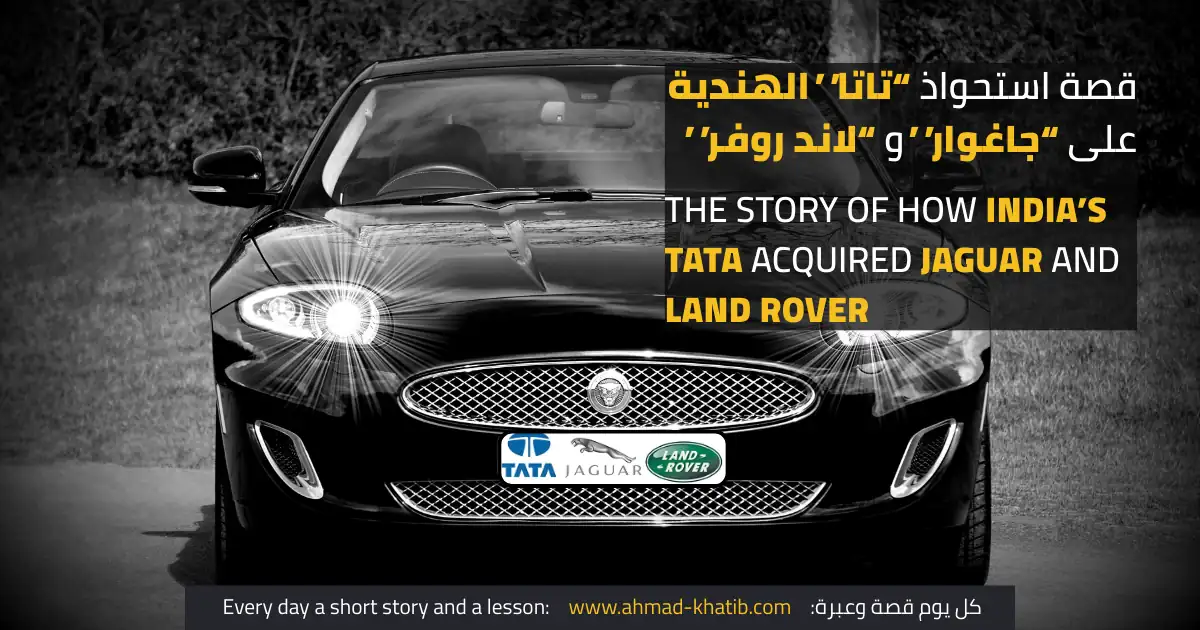قصة تاتا مع جاغوار ولاند روفر كيف أنقذت شركة هندية علامتين بريطانيتين بتفكير قيادي استثنائي 2008 - قصة وعبرة
وكان الخبر المثير أن شركة هندية قررت شراء العلامتين مقابل 2.3 مليار دولار. القرار كان مفاجئًا، فكيف لشركة من سوق ناشئ أن تستحوذ على اثنتين من أعرق العلامات الأوروبية في صناعة السيارات الفاخرة؟
كيف بدأت القصة؟
في عام 2008، أعلنت شركة Ford عن بيع علامتي Jaguar وLand Rover بعد سنوات من الخسائر وتراجع المبيعات. وكان الخبر المثير أن شركة هندية — hashtag#Tata Motors — قررت شراء العلامتين مقابل 2.3 مليار دولار. القرار كان مفاجئًا، فكيف لشركة من سوق ناشئ أن تستحوذ على اثنتين من أعرق العلامات الأوروبية في صناعة السيارات الفاخرة؟ لكن تاتا رأت ما لم يره الآخرون.
ماذا فعلت تاتا بعد الاستحواذ؟
- حافظت على هوية Jaguar وLand Rover، على “تراث وقيم العلامتين”: منحت تاتا للإدارة القديمة مرونة في إدارة عملياتها، فلم تجبرهم على اتباع ثقافة جديدة… بل دعمت الفريق لينهض بنفسه…
- ضخت استثمارات لتطوير المنتجات: ركزت تاتا على الاستثمار في مراكز البحث والتطوير، وتحسين سلسلة التوريد، وإعادة هيكلة التكاليف دون المساس بالجودة. كانت استراتيجية واضحة: تمكين + دعم + تطوير حقيقي.
النتيجة؟
تحسن سمعة العلامتين وإعادة بناء الثقة في السوق، حيث استعادت تاتا الربحية بعد سنوات من الخسائر، حيث تكبّدت الخسائر بعد الاستحواذ بسبب الأزمة المالية العالمية، لكنها تحولت بين 2011 و2013 إلى الربحية وبقوة. فأصبحت JLR أي “جاغوار” و “لاند روفر” أقوى مصدر دخل لتاتا موتورز، ارتفعت مبيعات العديد من الطرازات الجديدة (مثل Evoque)، وتم طرح موديلات جديدة أعادت الوهج للعلامة، في نجاح لم يأت على سبيل المصادفة، بل كان نتيجة لاستراتيجية هادئة وطويلة الأمد.
🔍 الدروس المستفادة
نجاح تاتا مع JLR كان درسًا في القيادة الاستراتيجية:
- رؤية بعيدة المدى
- احترام للهوية المؤسسية
- تمكين الفرق بدلاً من التحكم
- إدارة مخاطر محسوبة
- تحويل الأزمات إلى فرص نمو
هذه المبادئ ليست نظريات… هي أدوات عملية أستخدمها في عملي وخبرتي وتحليلي الإداري. وأبحث دوماً عن تحديات أطبّق فيها هذا النوع من التفكير: تحليل، فقيادة، فتحليل مستمر، فتحول مؤسسي، وتمكين مستدام لفرق العمل.
How India's TATA Revitalized Two Iconic British Brands JAGUAR and LAND ROVER Through Exceptional Leadership
How Did the Story Begin?
In 2008, Ford announced it would sell Jaguar and Land Rover after years of declining sales and operational losses.Then came the unexpected headline: India’s Tata Motors was acquiring both brands for $2.3 billion — a move many analysts found surprising. How could a manufacturer from an emerging market confidently take over two of Europe’s most prestigious luxury automotive names?
Tata, however, saw what others couldn’t.
What happened after the acquisition?
- Preserving brand identity and culture:Tata didn’t force a cultural reset. Instead, it empowered the existing leadership teams, respecting the legacy culture of both brands. The message was clear: “Lead your turnaround — we’re here to support, not dictate.”
- Strategic investment in creativity and product development:
Tata boosted R&D funding, strengthened supply chains, and restructured costs — all while maintaining uncompromising quality standards.
The strategy was simple and powerful: Enable. Support. Invest.
The Result?
A remarkable transformation. Despite initial losses during the global financial crisis, Tata turned Jaguar Land Rover profitable between 2011 and 2013.JLR quickly became Tata Motors’ strongest revenue engine, with new models like the Range Rover Evoque driving global demand and restoring the brands’ prestige.
It was the outcome of quiet, disciplined, long-term strategic leadership.
🔍 Lessons Learned
Tata’s success with JLR is a masterclass in leadership:- Long-term strategic vision
- Respect for organizational identity
- Empowerment over micromanagement
- Calculated risk-taking
- Turning crises into engines for growth
These aren’t just theories — they’re principles I apply in my work, leadership approach, and organizational analysis. I’m constantly looking for challenges where this mindset creates impact: strategic diagnosis, thoughtful leadership, continuous transformation, and sustainable team empowerment.
أحمد الخطيب
